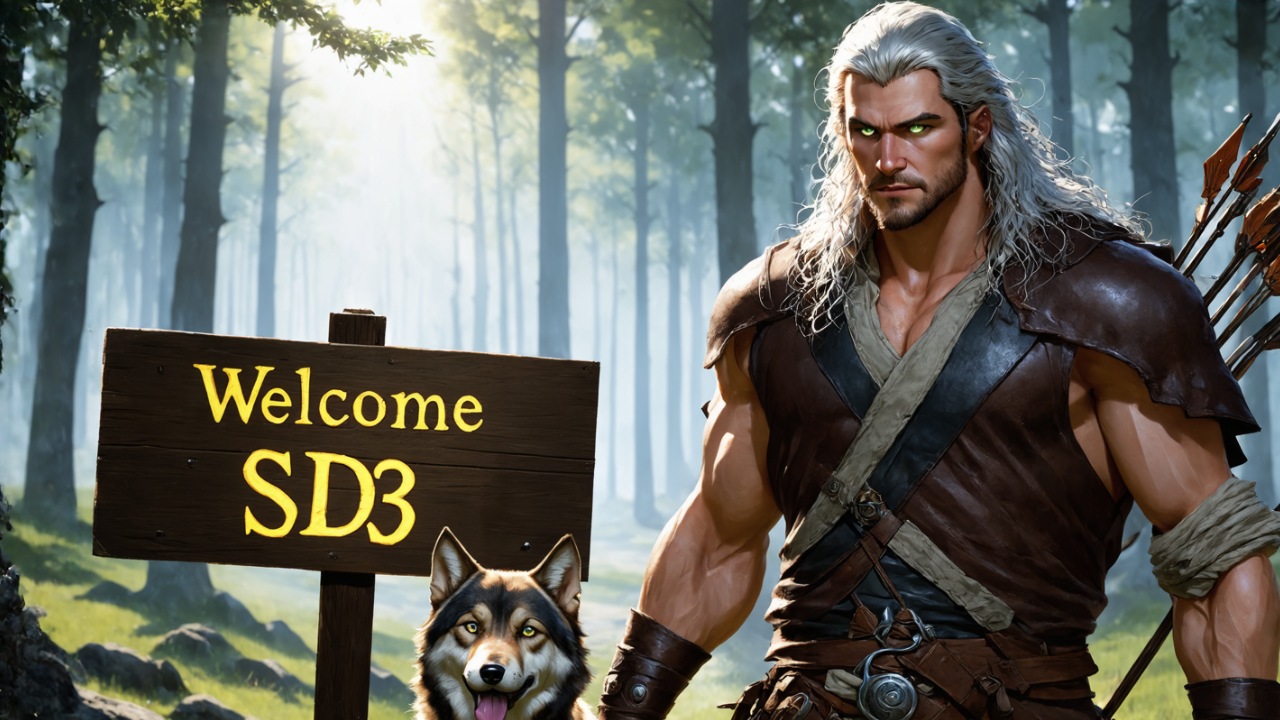Zero to Hero Stable Diffusion 3 Tutorial with Amazing SwarmUI SD Web UI that Utilizes ComfyUI
Published by Furkan Gözükara on June 27th, 2024
Full Tutorial on : https://youtu.be/HKX8_F1Er_w

Full Tutorial on : https://youtu.be/HKX8_F1Er_w
Do not overlook any section of this comprehensive guide to mastering Stable Diffusion 3 (SD3) with SwarmUI, the most advanced open-source generative AI application. As Automatic1111 SD Web UI and Fooocus do not currently support #SD3, I am initiating tutorials for SwarmUI as well. #StableSwarmUI, officially developed by StabilityAI, will astound you with its remarkable features once you complete this tutorial. Utilizing #ComfyUI as its backend, StableSwarmUI combines the powerful capabilities of ComfyUI with the user-friendly interface reminiscent of Automatic1111 #StableDiffusion Web UI. I find SwarmUI highly impressive and intend to create more tutorials for it.
🔗 Access the Public Post (no login or account required) Featured in the Video, Including Links
➡️ https://www.patreon.com/posts/stableswarmui-3-106135985
0:00 Overview of Stable Diffusion 3 (SD3), SwarmUI, and tutorial contents
4:12 SD3 architecture and key features
5:05 Explanation of various Stable Diffusion 3 model files
6:26 SwarmUI installation guide for Windows, compatible with SD3 and other Stable Diffusion models
8:42 Recommended folder path for SwarmUI installation
10:28 Troubleshooting installation errors
11:49 Initial steps for using SwarmUI post-installation
12:29 Customizing SwarmUI settings and theme options
12:56 Configuring SwarmUI to save generated images as PNG
13:08 Locating descriptions for settings and configurations
13:28 Downloading and implementing SD3 model on Windows
13:38 Utilizing SwarmUI's model downloader utility
14:17 Setting up model folder paths and linking existing model folders in SwarmUI
14:35 Understanding SwarmUI's Root folder path
14:52 SD3 VAE requirements
15:25 Navigating SwarmUI's Generate and Model sections for image creation and base model selection
16:02 Parameter setup and their effects on image generation
17:06 Optimal sampling method for SD3
17:22 Detailed look at SD3 text encoders and their comparison
18:14 First image generation using SD3
19:36 Image regeneration techniques
20:17 Monitoring image generation speed, step speed, and additional metrics
20:29 SD3 performance on RTX 3090 TI
20:39 Tracking VRAM usage on Windows 10
22:08 Testing and comparing various SD3 text encoders
22:36 Implementing FP16 version of T5 XXL text encoder instead of default FP8
25:27 Optimizing image generation speed with ideal SD3 configuration
26:37 Exploring SD3's superior VAE compared to previous Stable Diffusion models
27:40 Sourcing and downloading top AI upscaler models
29:10 Implementing refiner and upscaler models to enhance generated images
29:21 SwarmUI restart and launch procedures
32:01 Locating generated image save folders
32:13 Exploring SwarmUI's image history feature
33:10 Upscaled image comparison techniques
34:01 Batch downloading all upscaler models
34:34 In-depth look at presets feature
36:55 Setting up infinite image generation
37:13 Addressing non-tiled upscale issues
38:36 Comparing tiled vs non-tiled upscale for optimal results
39:05 Importing 275 SwarmUI presets (adapted from Fooocus) and associated scripts
42:10 Navigating the model browser feature
43:25 Generating TensorRT engine for significant speed boost
43:47 SwarmUI update process
44:27 Advanced prompt syntax and features
45:35 Implementing Wildcards (random prompts) feature
46:47 Accessing full image metadata
47:13 Comprehensive guide to powerful grid image generation (X/Y/Z plot)
47:35 Integrating downloaded upscalers from zip file
51:37 Monitoring server logs
53:04 Resuming interrupted grid generation process
54:32 Accessing and utilizing completed grid generation
56:13 Illustrating tiled upscaling seaming issues
1:00:30 Comprehensive guide to image history feature
1:02:22 Direct image deletion and starring
1:03:20 Implementing SD 1.5, SDXL models, and LoRAs
1:06:24 Determining optimal sampler method
1:06:43 Image-to-image conversion techniques
1:08:43 Image editing and inpainting methods
1:10:38 Utilizing advanced segmentation for automatic image inpainting
1:15:55 Applying segmentation to existing images for inpainting with varied seeds
1:18:19 Detailed insights on upscaling, tiling, and SD3
1:20:08 Addressing and resolving seam issues
1:21:09 Implementing queue system
1:21:23 Multi-GPU setup with additional backends
1:24:38 Loading models in low VRAM mode
1:25:10 Correcting color oversaturation
1:27:00 Optimal image generation configuration for SD3
1:27:44 Rapid upscaling of previously generated images via presets
1:28:39 Exploring additional SwarmUI features
1:28:49 CLIP tokenization and rare token OHWX
Stable Swarm UI: A Comprehensive Guide to Using Stable Diffusion 3 and Advanced AI Image Generation
Introduction
In this comprehensive tutorial, we explore the powerful capabilities of Stable Swarm UI, an officially developed interface by Stability AI for using Stable Diffusion 3 and other advanced AI image generation models. This article provides a detailed walkthrough of how to install, configure, and utilize Stable Swarm UI to create stunning AI-generated images with unprecedented control and flexibility.
1.1 Key Features of Stable Swarm UI
Stable Swarm UI offers a wide array of features that set it apart from other AI image generation interfaces:
Support for Stable Diffusion 3 and other Stable Diffusion models
Advanced features like automatic segmentation and inpainting
Wildcard functionality for dynamic prompt generation
LoRA (Low-Rank Adaptation) integration
Powerful grid generator for comparison and experimentation
Automated model downloading from CivitAI and Hugging Face
Multi-GPU support
Comprehensive image history management
Image-to-image and inpainting capabilities
Built-in model browser
Advanced upscaling options
1.2 Optimized Performance
One of the standout features of Stable Swarm UI is its impressive optimization. The tutorial demonstrates that even with the most advanced configuration of Stable Diffusion 3, utilizing both text encoders, the interface can run on GPUs with as little as 6GB of VRAM. This optimization is achieved through the backend use of ComfyUI, allowing for efficient resource management and broader accessibility.
Installation and Setup
2.1 System Requirements
Before installing Stable Swarm UI, ensure your system meets the following requirements:
Windows operating system (for this tutorial)
Git installed
.NET 8 installed
A GPU with at least 6GB VRAM (though more is recommended for optimal performance)
2.2 Installation Process
To install Stable Swarm UI on Windows:
Download the installation batch file from the official Stable Swarm UI repository.
Create a new folder for the installation (avoid spaces in the folder name).
Place the downloaded batch file in the new folder.
Run the batch file to initiate the installation process.
Follow the on-screen prompts to customize your installation settings.
The installer will automatically set up an isolated Python environment and install all necessary dependencies.
2.3 Initial Configuration
After installation, launch Stable Swarm UI and configure the following settings:
Choose your preferred theme (e.g., modern light)
Set the image output format to PNG for lossless quality
Configure model paths and other system settings as needed
Understanding Stable Diffusion 3
3.1 Model Architecture
Stable Diffusion 3 introduces several improvements over its predecessors:
Uses three models: Clip-G, Clip-large, and T5
Incorporates T5 XXL for enhanced text understanding
Employs an improved VAE (Variational Autoencoder)
Utilizes multiple MM-DiT (Multi-Modal Diffusion Transformer) blocks in the U-Net
3.2 Model Variants
Stable Diffusion 3 is available in several variants:
Base model (raw)
Model including Clips (text encoders)
Model including Clips and T5-XXL (fp16 version)
Model including Clips and T5-XXL (fp8 version)
For this tutorial, we focus on using the base model with separate text encoders for maximum flexibility.
Using Stable Swarm UI
4.1 Interface Overview
The Stable Swarm UI interface is divided into several key sections:
Generate: The main tab for creating images
Models: For browsing and managing installed models
Image History: To view and manage generated images
Utilities: Additional tools and features
Server: Backend configuration and logs
4.2 Generating Images
To generate images using Stable Diffusion 3:
Select the SD3 model from the dropdown menu.
Enter your prompt in the text field.
Configure generation parameters (steps, CFG scale, sampler, etc.).
Choose text encoders (Clip + T5 recommended for best results).
Set image dimensions (default is 1024x1024 for SD3).
Click "Generate" to create your image.
4.3 Advanced Prompting
Stable Swarm UI supports advanced prompting techniques:
Weighting: Use () to increase emphasis or [] to decrease emphasis on specific words.
Alternating: Use | to alternate between options.
Wildcards: Create dynamic prompts with randomly selected elements.
Example of a wildcard:
Copy
a cat {blue|red|yellow}
This prompt will randomly choose between blue, red, or yellow for each generation.
4.4 Using LoRAs
To use LoRAs (Low-Rank Adaptations) with Stable Swarm UI:
Download the desired LoRA model using the built-in model downloader or manually place it in the LoRA folder.
In the generate tab, select the LoRA from the dropdown menu or use the lora:modelname syntax in your prompt.
Adjust the LoRA strength as needed (default is 1.0).
4.5 Image-to-Image and Inpainting
Stable Swarm UI offers powerful image-to-image and inpainting capabilities:
Upload an initial image using the "Use as init" button.
Adjust the denoising strength to control how much of the original image is preserved.
For inpainting, use the built-in masking tools to select areas for regeneration.
Experiment with mask blur and mask shrink/grow options for refined control.
4.6 Automatic Segmentation
One of the most impressive features of Stable Swarm UI is its automatic segmentation capability:
Use the "segment" keyword in your prompt to target specific areas of the image.
Adjust segmentation parameters like threshold and mask grow/blur for precise control.
Combine segmentation with inpainting for targeted image editing.
Example:
Copy
a cat, segment eyes, blue cat eyes
This prompt will automatically detect and modify only the cat's eyes in the generated image.
Upscaling and Refining Images
5.1 Built-in Upscalers
Stable Swarm UI comes with a variety of built-in upscalers. To use them:
Enable the refiner in the generation settings.
Choose an upscaler model from the dropdown menu.
Set the upscale factor (e.g., 1.5x, 2x).
Adjust the refiner control percentage to balance detail preservation and new detail generation.
5.2 Tiled Upscaling
For large images or when working with limited VRAM, tiled upscaling can be useful:
Enable the "Refiner do tiling" option.
Experiment with different refiner control percentages to minimize seams and artifacts.
5.3 Best Practices for Upscaling
Use a lower refiner control percentage (around 30-35%) to minimize artifacts.
Experiment with different upscaler models to find the best one for your specific image.
Consider using the grid generator to compare multiple upscaling settings simultaneously.
The Grid Generator
The grid generator is a powerful tool for comparing different settings and models:
Navigate to the "Tools" tab and select "Grid Generator."
Choose "Web Page" as the output type for maximum flexibility.
Set up your grid parameters, selecting which variables to compare (e.g., steps, CFG scale, upscalers).
Click "Generate Grid" to create your comparison.
The resulting web page allows for easy filtering and sorting of results, making it an invaluable tool for fine-tuning your generation process.
Multi-GPU Support
Stable Swarm UI can utilize multiple GPUs for increased generation speed:
Go to the "Server" tab and select "Backends."
Add a new ComfyUI self-starting backend for each additional GPU.
Specify the GPU ID for each backend.
Save the configuration and restart Stable Swarm UI.
With multiple GPUs configured, the interface will automatically distribute generation tasks across available hardware.
Advanced Features and Customization
8.1 Presets
Create and use presets to quickly apply your favorite settings:
Configure your desired parameters in the generate tab.
Click "Create New Preset" and give it a name.
Use the preset by selecting it from the dropdown menu before generation.
8.2 Wildcards
Customize your prompt generation with wildcards:
Create a text file with one option per line.
Save the file in the wildcards folder.
Use the wildcard in your prompt with curly braces: {wildcard_name}
8.3 Custom Upscalers
Add your own upscaler models:
Download the desired upscaler model (e.g., from the Hugging Face model hub).
Place the model file in the models/upscale_models folder.
Restart Stable Swarm UI to detect the new upscaler.
Troubleshooting and Optimization
9.1 VRAM Management
If you're experiencing VRAM issues:
Lower the resolution of your initial generation.
Use tiled upscaling for larger images.
Experiment with different text encoder combinations.
Consider using fp16 or fp8 model variants for reduced VRAM usage.
9.2 Addressing Color Saturation
If your generated images are overly saturated:
Reduce the CFG scale (try values between 5-7).
Generate multiple images and select the best results.
Experiment with different samplers and schedulers.
9.3 Updating Stable Swarm UI
To ensure you have the latest features and bug fixes:
Close the Stable Swarm UI application.
Run the update_windows.bat file in your installation folder.
Restart Stable Swarm UI after the update is complete.
Community and Resources
10.1 Official Discord
Join the official Stable Swarm UI Discord server to:
Get help from the community and developers
Stay updated on the latest features and improvements
Share your creations and techniques
10.2 Documentation
Familiarize yourself with the official documentation:
Read the advanced prompting syntax guide
Explore additional features like ControlNet integration
Stay informed about new model compatibility and features
Conclusion
Stable Swarm UI represents a significant advancement in the field of AI image generation interfaces. Its combination of powerful features, optimized performance, and user-friendly design makes it an excellent choice for both beginners and advanced users of Stable Diffusion models.
By leveraging the unique capabilities of Stable Diffusion 3, such as its advanced text encoders and improved VAE, Stable Swarm UI opens up new possibilities for creative expression and precise image generation. The interface's flexibility in handling various models, LoRAs, and upscalers, coupled with its innovative features like automatic segmentation and the comprehensive grid generator, provides users with unprecedented control over their AI-generated artwork.
As the field of AI image generation continues to evolve rapidly, Stable Swarm UI stands out as a forward-thinking solution that not only keeps pace with the latest advancements but also provides a solid foundation for future innovations. Whether you're a digital artist, researcher, or enthusiast, mastering Stable Swarm UI will undoubtedly enhance your ability to create stunning, personalized AI-generated imagery.
By following the guidelines and best practices outlined in this article, you'll be well-equipped to explore the full potential of Stable Swarm UI and Stable Diffusion 3. Remember to experiment, stay updated with the latest developments, and engage with the community to continually refine your skills and push the boundaries of what's possible with AI-assisted image creation.

